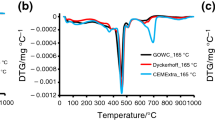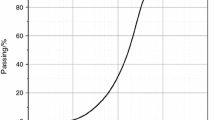Abstract
Partially hydrolysed polyvinyl alcohols (PVAs) are used commonly in polymer-modified mortars to manipulate their properties. These PVAs undergo hydrolysis in wet cement which results in the release of acetate groups into the pore water. To evaluate their contribution to cement hydration, the present work investigates the impact of acetic acid on the early hydration of off-white Portland cement using glacial acetic acid concentrations of up to 0.20 mass% (cement basis). To this end, the heat flow of the hydration of unmodified and acetic acid-modified cement pastes was monitored over the first 24 h following mixing using isothermal calorimetry, and the mineralogical compositions of these cement pastes were determined using quantitative X-ray diffraction analysis. Acetic acid addition showed a mixed effect. The slow reaction period was extended; in the acceleration period, the hydration of C3S to form calcium silicate hydrate (C-S-H) and Ca(OH)2 (CH) and the hydration reaction of C3A and gypsum to form ettringite were retarded; in the deceleration period, the exsolution of CaSO4 and renewed formation of ettringite were delayed, while the formation of monosulphate was accelerated. These effects were enhanced with increasing acetic acid concentration up to a surface adsorption acetate saturation level that could be identified from the curves of heat flow.








Similar content being viewed by others
References
Ohama Y. Handbook of polymer modified concrete and mortars. New Jersey: Noyes Publications; 1995.
Jenni A, Holzer L, Zurbriggen R, Herwegh M. Influence of polymers on microstructure and adhesive strength of cementitious tile adhesive mortars. Cem Concr Res. 2005;35:35–50.
Betioli AM, Gleize PJP, John VM, Pileggi RG. Effect of EVA on the fresh properties of cement paste. Cem Concr Compos. 2012;34:255–60.
Kim J-H, Robertson RE, Naaman AE. Structure and properties of poly(vinyl alcohol)-modified mortar and concrete. Cem Concr Res. 1999;29:407–15.
Mansur AAP, Santos DB, Mansur HS. A microstructural approach to adherence mechanism of poly(vinyl alcohol) modified cement systems to ceramic tiles. Cem Concr Res. 2007;37:270–82.
Georgescu M, Puri A, Coarna M, Voicu G, Voinitchi D. Thermoanalytical and infrared spectroscopy investigations of some mineral pastes containing organic polymers. Cem Concr Res. 2002;32:1269–75.
Knapen E. Microstructure formation in cement mortars modified with water-soluble polymers [Ph.D. Thesis]. Leuven: K.U.Leuven; 2007.
Singh NB, Rai S. Effect of polyvinyl alcohol on the hydration of cement with rice husk ash. Cem Concr Res. 2001;31:239–43.
Atkins KM, Edmonds RN, Majumdar AJ. The hydration of Portland and aluminous cements with added polymer dispersions. J Mater Sci. 1991;26:2372–8.
Le Saoût G, Kocaba V, Scrivener K. Application of the Rietveld method to the analysis of anhydrous cement. Cem Concr Res. 2011;41:133–48.
O’Connor BH, Raven MD. Application of the Rietveld refinement procedure in assaying powdered mixtures. Powder Diffr. 1988;3:2–6.
Jansen D, Goetz-Neunhoeffer F, Stabler C, Neubauer J. A remastered external standard method applied to the quantification of early OPC hydration. Cem Concr Res. 2011;41:602–8.
Tsurumi T, Hirano Y, Kato H, Kamiya T, Daimon M. Crystal structure and hydration of belite. Ceram Trans. 1994;13:19–25.
Hubbell JH, MacMaster WH, Grande NKD, Mallett JH. X-ray cross sections and attenuation coefficients. In: Ibers LA, Hamilton WC, editors. International tables for X-ray crystallography. Birmingham: The Kynoch Press; 1974. p. 47–70.
Lazǎu I, Pǎcurariu C, Ciobanu C. The use of thermal analysis to investigate the effects of cellulose ethers on the Portland cement hydration. J Therm Anal Calorim. 2012;110:103–10.
De La Torre ÁG, Bruque S, Campo J, Aranda MAG. The superstructure of C3S from synchrotron and neutron powder diffraction and its role in quantitative phase analyses. Cem Concr Res. 2002;32:1347–56.
Mondal P, Jeffery JW. The crystal structure of tricalcium aluminate, Ca3Al2O6. Acta Crystallogr Sect B Struct Sci. 1975;31:689–97.
Colville AA, Geller S. The crystal structure of brownmillerite, Ca2FeAlO5. Acta Crystallogr Sect B Struct Sci. 1971;27:2311–5.
De la Torre ÁG, López-Olmo M-G, Álvarez-Rua C, García-Granda S, Aranda MAG. Structure and microstructure of gypsum and its relevance to Rietveld quantitative phase analyses. Powder Diffr. 2004;19:240–6.
Weiss H, Bräu MF. How much water does calcined gypsum contain? Angew Chem Int Ed. 2009;48:3520–4.
Goetz-Neunhoeffer F, Neubauer J. Refined ettringite (Ca6Al2(SO4)3(OH)12·26H2O) structure for quantitative X-ray diffraction analysis. Powder Diffr. 2006;21:4–11.
Allmann R. Refinement of the hybrid layer structure [Ca2Al(OH)6]+ [0.5 SO4·3H2O)−. Neues Jahrbuch fuer Mineralogie Monatshefte 1977;3:136–44.
Petch H. The hydrogen positions in portlandite, Ca(OH)2, as indicated by the electron distribution. Acta Crystallogr. 1961;14:950–7.
Bond WL, Kaiser W. Interstitial versus substitutional oxygen in silicon. J Phys Chem Solids. 1960;16:44–5.
Bullard JW, Jennings HM, Livingston RA, Nonat A, Scherer GW, Schweitzer JS, Scrivener KL, Thomas JJ. Mechanisms of cement hydration. Cem Concr Res. 2011;41:1208–23.
Taylor HFW. Cement chemistry. 2nd ed. London: Thomas Telford Ltd; 1997.
Torréns-Martín D, Fernández-Carrasco L, Blanco-Varela M. Conduction calorimetric studies of ternary binders based on Portland cement, calcium aluminate cement and calcium sulphate. J Therm Anal Calorim. 2013;114:799–807.
Bullard JW, Enjolras E, George WL, Satterfield SG, Terrill JE. A parallel reaction-transport model applied to cement hydration and microstructure development. Model Simul Mater Sci Eng. 2010;18:1–16.
Smith A, El Hafiane Y, Bonnet JP, Quintard P, Tanouti B. Role of a small addition of acetic acid on the setting behavior and on the microstructure of a calcium aluminate cement. J Am Ceram Soc. 2005;88:2079–84.
Kong X, Emmerling S, Pakusch J, Rueckel M, Nieberle J. Retardation effect of styrene–acrylate copolymer latexes on cement hydration. Cem Concr Res. 2015;75:23–41.
Möschner G, Lothenbach B, Figi R, Kretzschmar R. Influence of citric acid on the hydration of Portland cement. Cem Concr Res. 2009;39:275–82.
Thomas NL, Birchall JD. The retarding action of sugars on cement hydration. Cem Concr Res. 1983;13:830–42.
Ismail M, Noruzman A, Bhutta M, Yusuf T, Ogiri I. Effect of vinyl acetate effluent in reducing heat of hydration of concrete. KSCE J Civ Eng. 2015. doi:10.1007/s12205-015-0045-5.
Chernov AA. Formation of crystals in solutions. Contemp Phys. 1989;30:251–76.
Damons RE, Petersen FW. An aspen model for the treatment of acid mine water. Eur J Miner Process Environ Prot. 2002;2:69–81.
Acknowledgements
The authors acknowledge the financial and technical support by Bostik Australia Pty. Ltd for this project. The lead author would like to thank UNSW Australia for his tuition fee waiver scholarship, which supported the completion of this work. The authors are grateful to Mr. Martin Weiman at Bostik Inc. for the measurement of the heats of reaction. The authors also acknowledge the Mark Wainwright Analytical Centre UNSW for the access to the X-ray diffractometer.
Author information
Authors and Affiliations
Corresponding author
Rights and permissions
About this article
Cite this article
Nguyen, D.D., Devlin, L.P., Koshy, P. et al. Effects of acetic acid on early hydration of Portland cement. J Therm Anal Calorim 123, 489–499 (2016). https://doi.org/10.1007/s10973-015-4942-0
Received:
Accepted:
Published:
Issue Date:
DOI: https://doi.org/10.1007/s10973-015-4942-0




